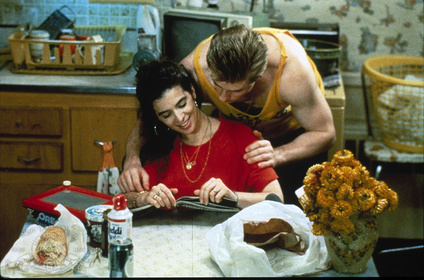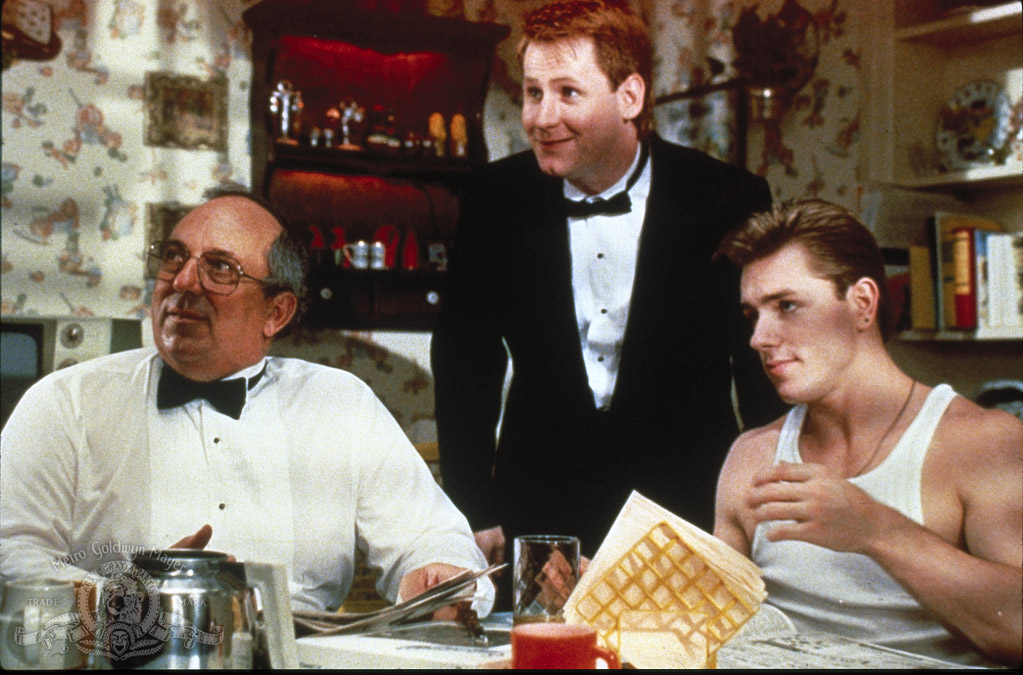Pink Stalls And Blue Mashed Potatoes: Thirty-Five Years Later(?) With The Bastones Of Morris Park, The Bronx
DIRECTOR: NANCY SAVOCA
STREET DATE: APRIL 23RD, 2024/KINO LORBER STUDIO CLASSICS

Alongside recent, simultaneous restorations of Nancy Savoca’s Dogfight (1991), to be released on home video by Criterion on April 30th, and Household Saints (1993), also on home video from Kino Lorber, Savoca’s first feature True Love (1989) – a 16mm film shot during the summer of 1988 in the streets, two-family houses, apartments, shops, bars, clubs, and reception halls of the Morris Park neighborhood of Bronx, New York City – receives a similar deluxe presentation on special edition Blu-ray. Contemporary to or immediately proceeding such personalized and localized views of Long Island, NY in Hal Hartley’s The Unbelievable Truth (1989) or upper Manhattan and upstate New York in Whit Stillman’s Metropolitan (1990), True Love also received considerable acclaim as an alternatively-funded East Coast production at the Sundance Film Festival and elsewhere, winning national distribution, widespread media coverage, and, subsequently, audience receipts effectively twice its entire production budget.
The independent film movement was born! In retrospect of the intervening thirty-five years of lower-budget filmmaking, True Love with its slice-of-life approach to otherwise familiar subjects touching family, friendship, romance, marriage – and, most pointedly, its immediate aftermath – remains what reviewers of the time found both bracingly “true to life” and “highly realistic”. Kino Lorber’s Blu-ray offers a keen revisit to both ground zero of American independent filmmaking into the 1990s and more importantly the debut feature of Nancy Savoca, who has heretofore been under-recognized as one of the former movement’s leading lights.

Opening on VHS recorder images of Donna (Anabella Sciorra) and Michael’s (Ron Eldard) engagement party, apparently viewed almost immediately after its celebration, the film follows along with their family and friends through the romantic pair’s subsequent week or so of preparation, carousing, fights, make-ups, and make-outs; leading up to the ceremony and reception itself, where the newly-joined Bastones must acknowledge and face the tensions of and second thoughts about their continuing relationship, either together or apart.

Probably the easiest plot description I’ve ever written, which to the film’s lasting credit provides a seamless comic-dramatic backdrop that essentially avoids the trappings, tropes, and tone of a conventional studio-funded rom-com of the period. Mainly by focusing on the characters above all else, the dialogue and situations arising naturally out of the aforementioned settings and realistically from the dynamics of the relationships depicted. In addition to Sciorra and Eldard, Aida Turturro, Vincent Pastore, Kelly Cinnante, Suzanne Costollos, Star Jasper, and Rick Shapiro, among others – many in their first movie roles, and most of whom would go on to represent various aspects of Italian-American life on television and in movies over the next several decades – the performances hardly seem such at all, Turtorro’s savvy best friend of the bride, Pastore’s camcorder-wielding bride’s dad, or Shapiro’s pill-popping loudmouth of a not-so-best man as vivid and recognizable as the last wedding you attended.

Extending to the music choice, fashions, hairstyles, attitudes, and language – the forty or so “fuck”s written in Nancy Savoca and Richard Guay’s script expanding through the cast’s consistently energetic line-reading to the expletive being employed as verb, adjective, adverb, and noun – the title qualifies its concept with a verisimilitude that no period piece could hope to attain without actual benefit of a time machine. My subheader describing “pink stalls and blue mashed potatoes” does in fact register heavily with the film’s inescapable time period, culminating with a five-piece band kicking off the reception with a hilariously lame cover of Kool and the Gang’s equally inescapable “Celebration”. By the end, the vast, accumulated detail attains a documentary-level of supreme self-accuracy, so to speak.
Which is ultimately why the here unspoiled ending itself rings so title-true, as not only Donna and Michael must acknowledge the painfully irreconcilable aspects of their relationship, and their individual, diverging notions of emotional “commitment”; but perhaps audience members themselves must also come to recognize in their final judgments of them (although while watching I would encourage viewers to suspend such judgment) the essential difficulty and perhaps fundamental unlikelihood of love remaining “true” in the death-parting long-term. Left once more with camcorder images of friends, neighbors, workmates, family and wedding members alike wishing the “happy couple” well over the ending credits, it is again to the film’s lasting credit that we as viewers are left to our own viewing devices some thirty-five years later as to whether or not Donna and Michael have recently celebrated their 35th wedding anniversary together.
Having recently celebrated their 40th, I gather, director/co-writer Nancy Savoca and producer/co-writer Richard Guay are undoubtedly in a better position than anyone to answer that last viewing question-mark, but if so they mainly keep such judgments to themselves in their somewhat muted feature-length commentary recorded for Kino Lorber’s special edition Blu-ray. While pleasant enough company throughout the listen-along, one might get a better idea of the film’s production background through Guay’s four separate interviews with key collaborators from the production, including music supervisor Jeffrey Kimball, production designer Lester Cohen, sound editor Tim Squyres, and editor John Tintori, the latter with script supervisor Mary Cybulski. One’s individual tolerance for Zoom-held interviews on static backgrounds of home libraries and such may vary, but all of those listed above have gone on to individually remarkable careers, and their insights and reminiscences on a shared early credit/project are uniformly invaluable.
Finally, KLSC’s presentation of this 35-year-old independent feature is eminently worthy of its slipcover, the indelible poster-image of Annabella Sciorra’s Donna Bastone nee Di Falco, in full bridal dress spilling over a presumably pink toilet (to match both the stall and its side-jutting paper-roll), is admirably representative of the title’s starkly bold-lettered first-word qualifying its elegantly cursive-scripted second one. While much has changed in the past thirty-five years, the 16mm shooting over a Bronx summer to its high-definition digital encoding on Blu-ray nevertheless retains its “old neighborhood” feel: familiar as yesterday, but as long ago as when your kids onscreen were themselves actually kids, smiling through a mouthful of blue mashed potatoes. Il tempo vola!
Images in this review are used only as a visual reference and do not reflect the picture quality of Kino Lorber’s Blu-ray.

